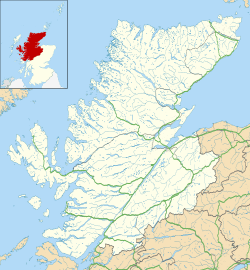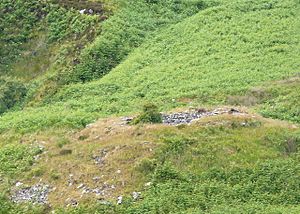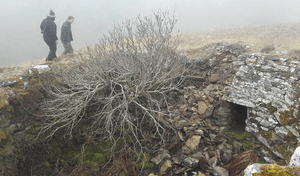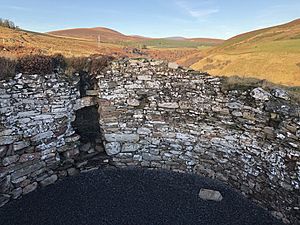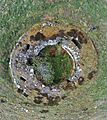Ousdale Broch facts for kids

Aerial view of Ousdale Broch
|
|
| Alternative name | Ousdale Burn Broch, Allt a' Bhurg Broch |
|---|---|
| Location | Caithness, Scottish Highlands |
| Coordinates | 58°08′54″N 3°34′46″W / 58.148449°N 3.579339°W |
| Type | Broch |
| History | |
| Periods | Iron Age |
The Ousdale Broch is an ancient stone tower from the Iron Age (around 2,000 years ago). It is located in Caithness, Scotland, between the villages of Helmsdale and Berriedale. A broch is a special type of drystone tower, meaning it was built using stones fitted together without any mortar.
For a long time, the Ousdale Broch was falling apart. But between 2015 and 2020, a group called the Caithness Broch Project worked hard to fix it. They made the tower strong again and brought back some of its original features. They also built a gravel path to make it easier for people to visit. Along the path, there are signs that tell you about the broch. This site is part of the John o' Groats Trail, a walking route, and the North Coast 500, a famous driving route.
Contents
Where is Ousdale Broch?
The Ousdale Broch is found near a small village called Ousdale, right by the A9 road. It's about 3.5 miles northeast of Helmsdale. It's also about 1 mile southwest of Badbea, which is a ruined village from the Highland Clearances.
The broch stands on a flat area at the bottom of a gentle hill. To the east, there's a deep valley with the Ousdale Burn (a small river). To the south, there's another smaller valley with the Allt a’ Bhurg. The area around the broch has native birch trees. Because of these trees, the area is a Site of Special Scientific Interest (SSSI). This means it's a special place protected for its nature by NatureScot.
What Does the Broch Look Like?
Ousdale Broch is thought to be a "second-phase" broch. This means it was built between 300 and 200 BC. It has a strong, solid base. The outside of the tower is about 16 metres wide. Some parts of the walls are still over 3 metres high! There might have been a ditch around the broch, and there are signs of other small buildings nearby.
The main entrance is on the southwest side. The path into the broch is 4.3 metres long, 1.78 metres high, and 75 centimetres wide. It still has most of its original stone roof slabs, called lintels. Inside the entrance, there are two sets of "door-checks." These are stone slots that would have held wooden doors. There is also a small room called a guard cell near the entrance.
The main space inside the broch is about 7 metres wide. There's a doorway that leads to a secret staircase built inside the wall. You can see similar staircases in other famous brochs like Mousa on Shetland and Dun Telve near Glenelg.
History of the Area
The land around Ousdale Broch is full of ancient history. The name "Ousdale" comes from the Norse language. This suggests that Vikings or Norse people lived here a long time ago. Other nearby towns like Helmsdale and Berriedale also have Norse names.
Ousdale is even mentioned in an old Viking story called the Orkneyinga Saga. In 1201, there was almost a fight here between William the Lion, the King of Scotland, and Harald the Elder, a powerful Norse ruler. King William heard that Harald was being cruel. So, he sent an army north to stop him. When they met at Ousdale, Harald saw that King William's army was much bigger. He asked for peace, and so the fight was avoided.
About 100 metres northwest of the broch, you can still see the ruins of Borg. This was a village from after the Middle Ages. It was abandoned during the Highland Clearances. The name "Borg" comes from an Old Norse word for "fort," probably referring to Ousdale Broch itself.
Digging Up the Past
In 1891, a man named James Mackay dug up parts of the Ousdale Broch. He mostly focused on the inside of the tower, so much of the outer wall stayed covered. During his dig, he found layers of ash and charcoal on the floor. This suggests people had fires inside. He also found broken animal bones, lots of common periwinkle and limpet shells (from seafood they ate), and wild hazelnuts.
Other items found included pieces of pottery, shiny lignite (a type of coal), quern-stones (used for grinding grain), whetstones (for sharpening tools), and a metalworking crucible (a pot for melting metal). They also found discs made of mica schist and part of a jet armlet (a type of bracelet). There was also a piece of a wooden dish or scoop. These finds show a mix of different Iron Age styles, perhaps because Ousdale was a meeting point for different groups of people who built brochs.
A human skeleton was also found buried face-down near the entrance to the stairs. When it was looked at in 1891, people thought it was from a more recent time, after the Middle Ages. Sadly, the skeleton is now lost, so we can't study it today. It's a bit of a mystery. It might have been someone who was buried in an unusual way, or perhaps a victim of a fight from earlier centuries.
Because of the digging in 1891, the broch became unstable. So, James Mackay built a support wall inside the broch to keep it from falling down.
Making the Broch Safe Again
From 2015 to 2020, a lot of work was done to make Ousdale Broch safe and stable. Before this, the support wall built by Mackay had fallen down. A large tree was growing inside the broch, and some of the stone walls were starting to bulge inwards.
The Caithness Broch Project started and managed all these repairs. They got approval from Historic Environment Scotland. Then, experts checked the structure and made a detailed plan for the repairs. They also successfully applied for money to pay for the work, the information signs, and a new car park and path.
In 2019, archaeologists from Clyde Archaeology carefully recorded the broch before any work began. Then, they cleared away plants, including the big tree. After that, they started making the structure strong again. Some parts, like the inside staircase and one of the two corbelled guard cells (small rooms with arched roofs), were repaired. A small stone cupboard called an aumbry was even rebuilt. To make the cells, walls, and entrance passage stable, they used a new method with hardwood pins. Finally, they laid down special fabric and gravel inside the broch to make it safe for visitors. This was a technique also used at Achvarasdal broch.
A new car park and path from the A9 road were built by RJ Macleod and Highland Conservation Ltd. The Caithness Broch Project created and put up signs along the path. These signs tell the story of the area and the broch, creating a short heritage trail for everyone to enjoy.
Images for kids


